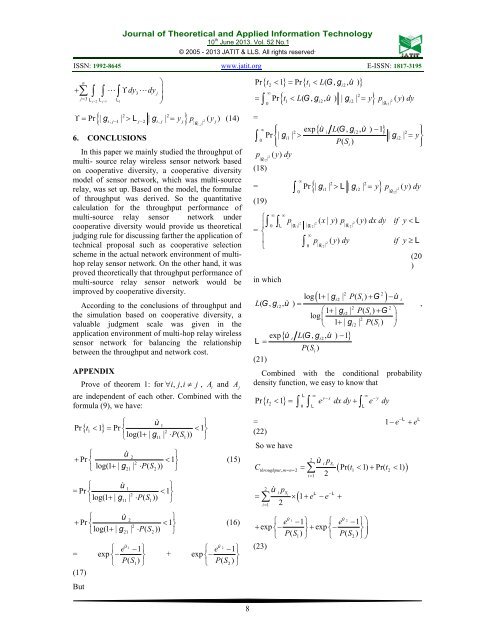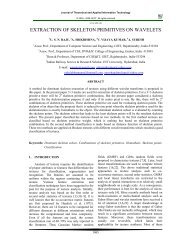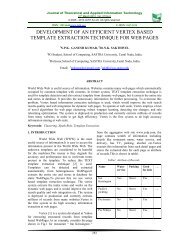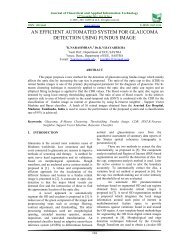Full Text - Journal of Theoretical and Applied Information Technology
Full Text - Journal of Theoretical and Applied Information Technology
Full Text - Journal of Theoretical and Applied Information Technology
You also want an ePaper? Increase the reach of your titles
YUMPU automatically turns print PDFs into web optimized ePapers that Google loves.
<strong>Journal</strong> <strong>of</strong> <strong>Theoretical</strong> <strong>and</strong> <strong>Applied</strong> <strong>Information</strong> <strong>Technology</strong><br />
10 th June 2013. Vol. 52 No.1<br />
© 2005 - 2013 JATIT & LLS. All rights reserved .<br />
ISSN: 1992-8645 www.jatit.org E-ISSN: 1817-3195<br />
n<br />
⎞<br />
+ ∑ ∫ ∫ ∫ϒdy3<br />
dy<br />
j<br />
j=<br />
3<br />
⎟<br />
Lj−2 Lj−1 L1<br />
⎠<br />
{ t < } = { t < LG g ù }<br />
Pr 1 Pr ( , , )<br />
2 1 i2<br />
∞<br />
2<br />
{ 1<br />
G gi2 g<br />
i2 } 2<br />
| |<br />
= ∫ t < L ù = y p y dy<br />
g<br />
Pr ( , , ) | | ( )<br />
0 i 2<br />
2 2<br />
{ , −1 L<br />
−2 , } 2<br />
| g |<br />
ϒ= Pr | g | > | g | = y p ( y ) (14)<br />
i j j i j j j<br />
i,<br />
j<br />
6. CONCLUSIONS<br />
In this paper we mainly studied the throughput <strong>of</strong><br />
multi- source relay wireless sensor network based<br />
on cooperative diversity, a cooperative diversity<br />
model <strong>of</strong> sensor network, which was multi-source<br />
relay, was set up. Based on the model, the formulae<br />
<strong>of</strong> throughput was derived. So the quantitative<br />
calculation for the throughput performance <strong>of</strong><br />
multi-source relay sensor network under<br />
cooperative diversity would provide us theoretical<br />
judging rule for discussing farther the application <strong>of</strong><br />
technical proposal such as cooperative selection<br />
scheme in the actual network environment <strong>of</strong> multihop<br />
relay sensor network. On the other h<strong>and</strong>, it was<br />
proved theoretically that throughput performance <strong>of</strong><br />
multi-source relay sensor network would be<br />
improved by cooperative diversity.<br />
According to the conclusions <strong>of</strong> throughput <strong>and</strong><br />
the simulation based on cooperative diversity, a<br />
valuable judgment scale was given in the<br />
application environment <strong>of</strong> multi-hop relay wireless<br />
sensor network for balancing the relationship<br />
between the throughput <strong>and</strong> network cost.<br />
APPENDIX<br />
Prove <strong>of</strong> theorem 1: for ∀i, ji , ≠ j, A<br />
i<br />
<strong>and</strong> A<br />
j<br />
are independent <strong>of</strong> each other. Combined with the<br />
formula (9), we have:<br />
⎧ ù<br />
⎫<br />
1<br />
Pr{ t1 < 1} = Pr ⎨<br />
< 1<br />
2 ⎬<br />
⎩log(1 + | g11 | ⋅PS<br />
(<br />
1))<br />
⎭<br />
⎧ ù<br />
⎫<br />
2<br />
+ Pr ⎨<br />
< 1<br />
2 ⎬<br />
⎩ log(1 + | g21 | ⋅PS<br />
(<br />
2<br />
)) ⎭<br />
⎧ ù<br />
⎫<br />
Pr < 1⎬<br />
⎩log(1 | | ( )) ⎭<br />
1<br />
= ⎨<br />
2<br />
+ g11 ⋅PS1<br />
⎧ ù<br />
⎫<br />
2<br />
+ Pr ⎨<br />
< 1<br />
2 ⎬<br />
⎩log(1 + | g21 | ⋅PS<br />
(<br />
2<br />
)) ⎭<br />
=<br />
(17)<br />
But<br />
ù 1<br />
⎧ e −1⎫<br />
exp ⎨−<br />
⎬<br />
⎩ PS (<br />
1)<br />
⎭<br />
+<br />
(15)<br />
(16)<br />
ù 2<br />
⎧ e −1⎫<br />
exp ⎨−<br />
⎬<br />
⎩ PS (<br />
2<br />
) ⎭<br />
=<br />
∞ ⎧⎪<br />
2<br />
exp { ù<br />
i<br />
L( G, gi2, ù ) −1}<br />
2<br />
⎫⎪<br />
∫ Pr ⎨| g<br />
0<br />
i1 | > | gi2<br />
| = y⎬<br />
⎪⎩<br />
PS (<br />
i<br />
)<br />
⎪⎭<br />
p 2 ( y)<br />
dy<br />
| gi<br />
2 |<br />
(18)<br />
∞<br />
Pr | g |<br />
0<br />
1<br />
> | g | ( )<br />
2<br />
=<br />
| i 2 |<br />
∫ i<br />
L<br />
i<br />
y p y dy<br />
g<br />
2 2<br />
= { } 2<br />
(19)<br />
∞ ∞<br />
⎧ p<br />
2 2( x | y) p 2 ( y)<br />
dx dy if y <<br />
⎪∫ 0 ∫<br />
L<br />
L | gi1| | gi2|<br />
| gi<br />
2 |<br />
= ⎨<br />
∞<br />
⎪<br />
p 2 ( y)<br />
dy if y ≥<br />
⎩ ∫<br />
L<br />
0 | gi<br />
2 |<br />
(20<br />
)<br />
in which<br />
L( G, g , )<br />
2 2<br />
( g<br />
2<br />
PS G )<br />
log 1 + | | ( ) + −ù<br />
i i i<br />
i2 ù =<br />
2 2<br />
⎛1 + | gi2<br />
| PS (<br />
i)<br />
+ G ⎞<br />
log ⎜<br />
2 ⎟<br />
1 + | gi2<br />
| PS (<br />
i)<br />
⎝<br />
exp ù<br />
i<br />
L( G, gi2, ù ) −1<br />
L =<br />
PS (<br />
i<br />
)<br />
(21)<br />
{ }<br />
Combined with the conditional probability<br />
density function, we easy to know that<br />
{ }<br />
y−x −y<br />
Pr t < 1 = e dx dy + e dy<br />
0<br />
2<br />
L<br />
∫ ∫<br />
∞<br />
L<br />
∞<br />
L<br />
−L<br />
= 1− e + e<br />
(22)<br />
So we have<br />
2<br />
ipS C<br />
i<br />
throughput, m= n=<br />
2<br />
= ∑ ù<br />
( Pr( t1 < 1) + Pr( t2<br />
< 1) )<br />
2<br />
i=<br />
1<br />
i=<br />
1<br />
2 ù<br />
ipS i<br />
L<br />
= ∑ × ( 1+ e − e − L<br />
+<br />
2<br />
ù 1 ù 2<br />
⎧ e −1⎫ ⎧ e −1⎫⎞<br />
⎨ ⎬ exp ⎨ ⎬<br />
PS (<br />
1) PS (<br />
2)<br />
⎟<br />
⎩ ⎭ ⎩ ⎭⎠<br />
+ exp − + − ⎟<br />
(23)<br />
∫<br />
⎠<br />
L<br />
,<br />
8
















